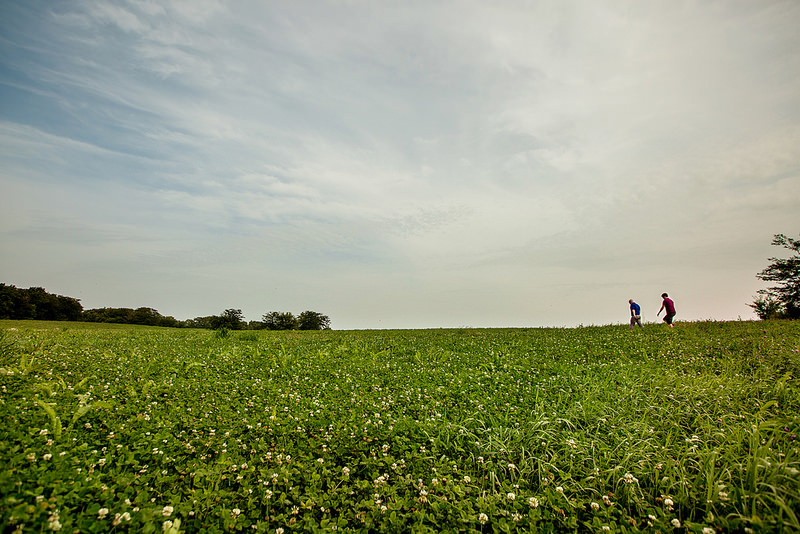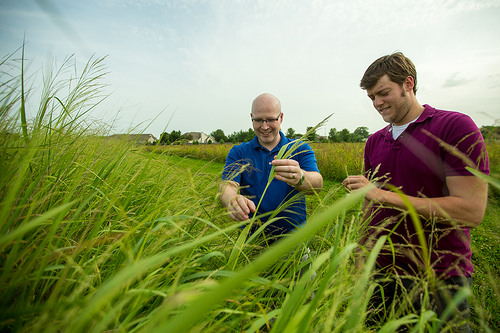EIU to Reap Research Opportunities Through Land Use Partnership
Aug-22-2014 |
| Bioenergy professor Thomas Canam and Ryan Kalinoski, a sustainable energy graduate student, walk through a field near Charleston where switchgrass and big bluestem has been planted in conjunction with research efforts through the Eastern Illinois University Center for Clean Energy Research and Education. (Jay Grabiec) |
**********
For some students at Eastern Illinois University, the traditional, enclosed classroom will soon be replaced with acres of wind-blown native grasses.
Via an arrangement that Thomas Canam, assistant professor of biological sciences, terms a “win-win-win situation for everyone,” some local landowners have agreed to allow Eastern to use nearly 120 acres of their Coles County property for research. Students and faculty of the university, as well as others, eagerly anticipate those enhanced research opportunities. And, in turn, area farmers will gain additional insight into potential alternative crops.
“This project is going to be helpful to us in so many ways,” Canam said.
While never slated to become a school for agricultural research, Eastern began exploring its expanded options even while the university’s now three-year-old Renewable Energy Center was in its planning stages. The REC, built to replace a decades-old, deteriorating coal-burning facility, was designed as a biomass-burning facility; two of its four boilers burn biomass, or biological material, while the other two boilers burn natural gas with a fuel oil backup.
When the opportunity arose for Eastern to partner with the Lumpkin family of Mattoon and their farm services manager, First Mid-Illinois Bank & Trust, the university was faced with the specific decision as to what it would do with access to the roughly 120-acre plot of land located northwest of Charleston.
“The Lumpkin family has been involved with sustainability for some time, and has been growing organic crops on the land,” Canam said. “We talked with them about the Renewable Energy Center and its needs for the future – that we wanted to grow an alternative fuel for the Renewable Energy Center and that we wanted to grow biomass in a sustainable way.”
Working in partnership with FDC Enterprises Inc., a nationally recognized provider of conservation services and green biofuels/bioproducts, Eastern authorized the planting of 100 acres of a “seed-pooled mixture of two warm season grasses.” The planting occurred in July.
“It was a mixture of switchgrass and big bluestem, both of which are known to be high yielding, robust and fast-growing,” Canam said.
In addition, FDC Enterprises planted “pollinator buffers” – wildflowers and other grasses, mostly – along the perimeter of the land and beside the portion of Riley Creek that runs through the land. While it does little to enhance the growth of the primary grass crop, the buffer does give the property a more striking appearance, attracting bees, butterflies and other species of wildlife.
Canam further explained that the attraction of wildlife will provide added research opportunities for EIU students and faculty.
“In addition to our primary research goal, we’re interested in how wildlife will respond to the changes,” Canam continued. “Nesting practices, shelter… It’s really a wonderful opportunity to also study wildlife dynamics with my colleagues Drs. Karen Gaines and Jill Deppe.”
While student and faculty researchers wait for the first switchgrass/big bluestem mixture harvest, likely to take place in 2015, they’ll carefully observe the grasses’ growth patterns: Do they do better on slopes than near the creek? Do they invite or discourage specific pest (bugs, molds, etc.) problems? And, do they react favorably with the soil and climate in which they are growing?
“We’ll be performing basic growth research,” Canam said.
Studies following the harvest will expand to include yield measurements (tons per acre, for example) and answers to questions that a biochemist, like Canam, is interested in.
“We’ll want to determine what, chemically, we can do with these grasses,” he said. “How much carbon is produced, and how much ash?
“And we’ll do density studies to help us determine how much money and resources will be needed to turn the grasses into pellet material that can be used to fuel facilities like our Renewable Energy Center,” he added. “Obviously, what we’re looking for is a resource that will require as little input as possible, thereby keeping growers’ costs down.”
 |
|
Canam and Kalinoski examine a test field of switchgrass. |
And cost conservation, Canam said, is something that’s just as important to EIU as it is for a traditional farmer.
In addition to a contribution from the university’s College of Sciences to get the project started, another $20,000 ($5,000 annually for four years) was awarded to Canam, Gaines and Deppe via EIU’s President’s Fund for Research and Creative Activity.
That fund exists to “foster, stimulate and strengthen research and creative activity conducted by faculty members, with a primary goal of enhancing the likelihood that their work will be competitive for external funding from federal agencies, state agencies, corporations, or private foundations.” Canam hopes that is, indeed, the case with the Lumpkin land research.
“We’ve been looking for external grants for research, but it’s a very competitive process,” he said. “Sources like the Department of Energy, the U.S. Department of Agriculture and the Environmental Protection Agency… In general, they’re looking for more large-scale projects than what we’ve been able to offer thus far.”
To date, he added, Eastern’s alternative crop research has been limited to four acres of small plots located near the university’s Renewable Energy Center. Two acres have been planted with hybrid poplars, a specifically bred, fast-growing tree; two additional acres have been planted with grasses.
“Now that we’re dealing with a fairly significant amount of land and we have something actually in progress, these larger funding agencies might take a better look at us,” Canam said. “It really helps for them to see you actually have the capabilities.”